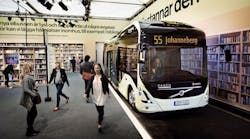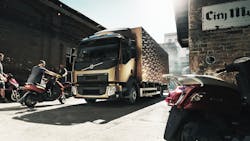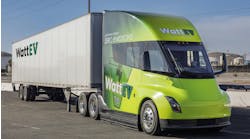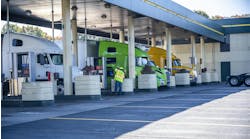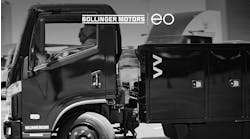Vehicle makers steering more toward EVs, including with heavy trucks
Electric-powered, larger-class distribution trucks could replace groups of smaller delivery vans in urban use while also allowing certain logistics advantages, Volvo Trucks suggested yesterday. The company said it plans to start selling electric trucks in Europe in 2019 — "select" customers will see the first of them this year — while advancements in battery technology are helping to "accelerate viability" of commercial EVs for North American duty cycles.
Volvo pointed to its experience with electric and hybrid-electric power in buses, although that's also more a worldwide strategy at present than one established in this market, where the Volvo Buses 9700 coach comes with a 13L diesel. Globally, though, the company noted it has sold more than 3,700 hybrid buses in countries including the United Kingdom, Germany, Norway, Sweden, Switzerland, the Netherlands, Brazil and Australia.
More EVs in the works
About as often as vehicle manufacturers bring up self-driving capabilities today, there's talk of shifting toward electric power — more so than any other alternative fuel has been able to spark. A standout recent example is Ford, which last week said it would up its planned investment in EVs to $11 billion by 2022, much higher than the $4.5 billion by 2020 the company cited last October.
Also by 2022, Ford said it plans to offer 40 vehicles with electric power of some kind, including 16 full battery-electrics and the rest being hybrids. On that note, the OEM noted it will make hybrid versions of all its mainstream U.S. models such as the Mustang, F-150 and Transit, but also said it is working on a battery-electric, high-performance SUV called the Mach I that will offer a 300-mile range. That vehicle is slated for launch in 2020.
Although light- and medium-duty EVs are more common, Kenworth, Nikola, Tesla, Toyota and Cummins are several OEMs that made news in the last year with electric heavy-duty trucks. Now, Volvo Trucks said it expects, as others do, that the best application for battery-electric trucks initially will be in denser urban areas and city centers.
But those electric trucks could be bigger than the light- or medium-duty vans and other vehicles that are often used or envisioned in such locations, which would mean greater freight-carrying capability, the company noted.
"Distribution trucks have just over 10 times the load capacity of a regular van," Volvo said in a statement. And if those larger distribution trucks are electric rather than diesel-powered, they also have much less of two things all big cities need to reduce: noise and air pollution.
Rethinking logistics
Because they tiptoe around, essentially, compared to their diesel counterparts, electric trucks — including heavier-duty distribution ones — could theoretically be used more at night and in "off hours" to further reduce truck congestion on roadways. That would mean fewer accidents as well, Volvo Trucks pointed out, since fewer people would be out on the roads.
"Urban distribution and other pick-up and delivery applications are a starting point for battery-powered electric trucks, but we envision broader deployment of electric trucks for freight movement in North America as technologies and the market mature," stated Göran Nyberg, president of Volvo Trucks North America (VTNA).
However, EVs of any kind also need the appropriate infrastructure in place before they'll see a wide expansion in use, the company noted. "The vehicles themselves are only one part of what is needed for large-scale electrification to succeed," said Keith Brandis, vice president for product planning at VTNA.
Even so, electric vehicles will be "part of our future," he contended, pointing to Volvo Group's history with hybrid and electric buses. While VTNA builds Class 8 trucks for the North American market, Volvo Trucks has a broader range of offerings in Europe and elsewhere that includes lighter cab-over-engine models.
Part of the drive toward EVs, according to Volvo, is coming from projections by the United Nations and others that during the 2020s, urban populations — many of them already tight today — will swell to about 125% of their present levels. By 2030, 60% of the world's population will be in cities, and VTNA said it expects things like electric heavy trucks will be needed to sustain those cities.
